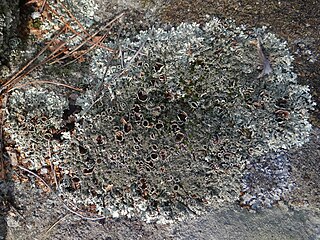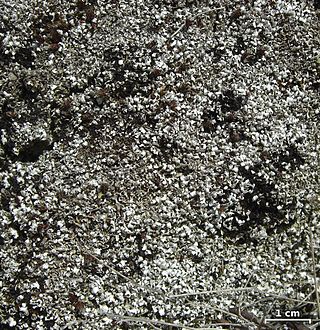
Erik Acharius was a Swedish botanist who pioneered the taxonomy of lichens and is known as the "father of lichenology." Acharius was famously the last pupil of Carl Linnaeus.

Parmelia is a genus of medium to large foliose lichens. It has a global distribution, extending from the Arctic to the Antarctic continent but concentrated in temperate regions. There are about 40 species in Parmelia. In recent decades, the once large genus Parmelia has been divided into a number of smaller genera according to thallus morphology and phylogenetic relatedness.

The Parmeliaceae is a large and diverse family of Lecanoromycetes. With over 2700 species in 71 genera, it is the largest family of lichen-forming fungi. The most speciose genera in the family are the well-known groups: Xanthoparmelia, Usnea, Parmotrema, and Hypotrachyna.
Everniopsis is a fungal genus in the family Parmeliaceae. It consists of a single species, the bark-dwelling lichen Everniopsis trulla, which occurs in Africa and South America.
Menegazzia cincinnata is a species of foliose lichen from southern South America. It was first scientifically described by Swedish lichenologist Erik Acharius as Parmelia cincinnata. Friedrich August Georg Bitter transferred it to the genus Menegazzia in 1901.

Anzia is a genus of foliose lichens known as black-foam lichens in the large family Parmeliaceae. It was formerly included in the monogeneric family Anziaceae, but this has since been subsumed into the Parmeliaceae.

Ernst Stizenberger was a German physician and lichenologist.

Xanthoparmelia conspersa, commonly known as the peppered rock-shield, is a foliose lichen and the type species of genus Xanthoparmelia. It is widely distributed in temperate zones, and has been recorded from Japan, Europe, Africa, North America, and South America.

Parmelia saxatilis, commonly known as the salted shield lichen or crottle, is a species of foliose lichen in the family Parmeliaceae. Several morphologically similar species, formerly lumped together, are now distinguished by their DNA.

Niebla homalea is a species of fruticose lichen that grows on rocks in foggy areas along the Pacific Coast of North America, from Mendocino County, California south to Bahía de San Quintín on the main peninsula of Baja California, with an isolated occurrence further south on vertical rock faces above Punta Camachos, and other occurrences in the Channel Islands and on Guadalupe Island. The epithet homalea, given by Acharius, suggests it was in regard to the branches appearing flattened.

Lecanora argopholis is a species of crustose lichen in the family Lecanoraceae. It was originally named Parmelia atra var. argopholis by Erik Acharius in 1803, then transferred by him to the genus Lecanora in 1810. The lichen has a circumpolar distribution.

Cladonia cariosa, the split-peg lichen or the split-peg soldiers cup lichen, is a species of fruticose, cup lichen in the family Cladoniaceae. It was first formally named by Erik Acharius in 1799 as Lichen cariosus and transferred to the genus Cladonia in 1827 by Kurt Polycarp Joachim Sprengel. It has a broad distribution, occurring in Europe, Asia, North America, and South America.

Solorina spongiosa, commonly known as the fringed chocolate chip lichen, is a species of lichen in the family Peltigeraceae. It was first formally described as a new species by the Swedish lichenologist Erik Acharius as Collema spongiosum. Italian botanist Martino Anzi transferred it to the genus Solorina in 1862.
Punctelia ulophylla is a species of foliose lichen in the family Parmeliaceae. It is found in Europe, where it grows on the bark of a variety of trees.

Parmelia omphalodes is a species of foliose lichen in the family Parmeliaceae. It is one of the several dozen lichen species first described in 1753 by Carl Linnaeus. Swedish lichenologist Erik Acharius transferred it to the genus Parmelia in 1803. The lichen is widely distributed, having been recorded in Asia, Africa, Europe, and North and South Americas. Morphologically similar–but genetically distinct–species include Parmelia discordans and P. pinnatifida.

Solorina crocea, commonly known as the orange chocolate chip lichen, is a species of terricolous (ground-dwelling) and foliose (leafy) lichen in the family Peltigeraceae. The lichen, which was first formally described by Carl Linnaeus in 1753, has an arctic–alpine and circumpolar distribution and occurs in Asia, Europe, North America, and New Zealand. It generally grows on the bare ground in sandy soils, often in moist soil near snow patches or seepage areas. Although several forms and varieties of the lichen have been proposed in its history, these are not considered to have any independent taxonomic significance.
Psoronactis is a monotypic fungal genus in the family Roccellaceae. It contains the single species Psoronactis dilleniana, a saxicolous (rock-dwelling), crustose lichen. This species was first described in 1799 by Swedish lichenologist Erik Acharius as Lichen dillenianus. The taxon was shuffled to several genera in the 1800s as different authors had different opinions on how to classify the species; in more modern times, it was transferred to genus Lecanographa in 2013. Psoronactis was circumscribed in 2014 by Damien Ernst and Anders Tehler, following molecular phylogenetic analysis and revision of the Roccellaceae that showed the species occupied a distinct lineage in the family. The genus name alludes to the lichen products present in its thallus: psoromic acid and 2'-O-demethylpsoromic acid. It is these compounds that differentiate it chemically from the similar genus Lecanactis.

Imshaugia aleurites, commonly known as the salted starburst lichen, is a species of foliose lichen in the family Parmeliaceae. It has a wide distribution in Europe and North America, and has also been recorded in China.

Opegrapha vulgata is a species of corticolous (bark-dwelling) script lichen in the family Graphidaceae. It was first scientifically described by Swedish lichenologist Erik Acharius in 1798, as Lichen vulgata. He transferred it to the genus Opegrapha in 1803. The lichen has a cosmopolitan distribution, and grows on the bark of a wide variety of tree species. Opegrapha niveoatra is similar in appearance, but can be distinguished form O. vulgata by its longer, curved conidia. O. lithygra is another lookalike, but it grows on rocks instead of bark.
Calicium corynellum is a species of pin lichen in the family Caliciaceae. It is found scattered across parts of Europe, North America, and Asia, where it grows on rock surfaces in shaded and humid locations.















